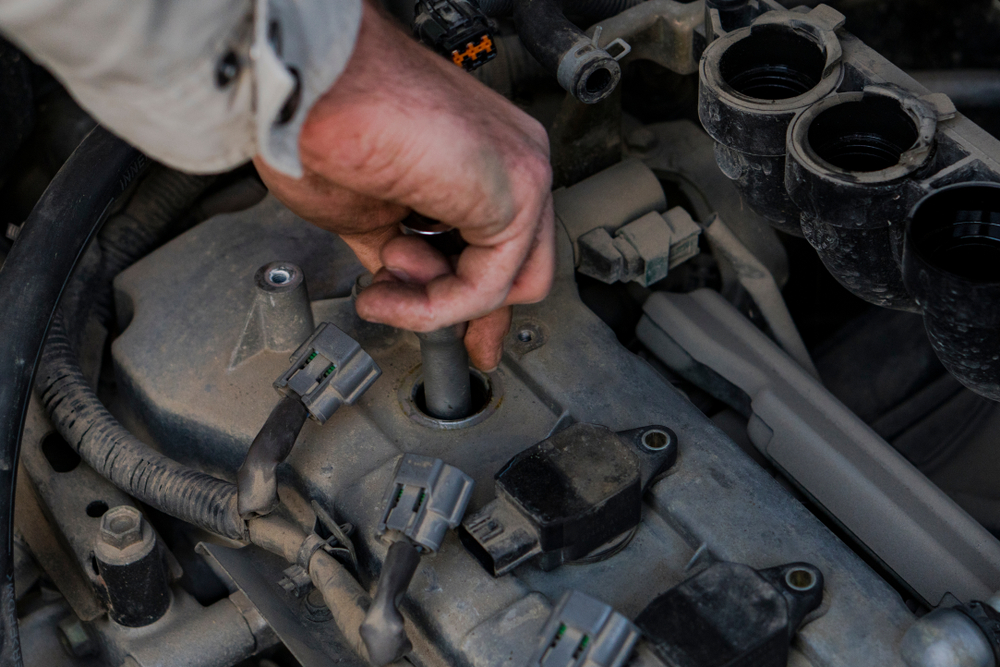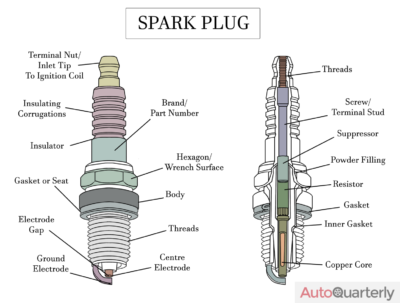Since spark plugs have to be changed from time to time, it’s important to know the spark plug replacement cost for your make and model of vehicle.
So, read on to learn all you need to know about this important engine component, how to replace spark plugs yourself, and how much it will cost to replace them professionally.
- What Is a Spark Plug?
- How Do Spark Plugs Work?
- How Do I Know if There’s a Problem With My Spark Plugs?
- Why Should I Change My Spark Plugs?
- How Often Should I Change My Spark Plugs?
- What Happens When Spark Plugs Are Replaced?
- Can I Replace Spark Plugs Myself? – A Replacement Guide
- What Is the Cost of Replacing Spark Plugs?
- Wrapping Up
What Is a Spark Plug?
Spark plugs have a vital role to play in any car. They’re essential for igniting the fuel and air mix inside the engine combustion chamber as they deliver an electrical current from the vehicle’s ignition system.
With the spark provided by this key component, the piston is forced back down to turn the crankshaft. As a result, the engine is powered and the car can go. Without functioning spark plugs, the car cannot operate correctly, or indeed, at all.
How Do Spark Plugs Work?
Spark plugs are screwed into the cylinder head of the engine and protrude in the engine cylinder’s bore. Once the ECU of the engine has deemed the piston has reached the right position to detonate the air/fuel mix, it transmits a signal onto a coil pack which manages the voltage feed to the vehicle’s spark plug. Then, the coil increases the voltage, sending it on to the spark plugs to force an arc of electricity to take place between the plug’s earthing body and the electrode. The spark (or arc) ignites the mixture of fuel and air to cause an explosion. This explosion pushes the piston down to rotate the engine.
How Do I Know if There’s a Problem With My Spark Plugs?
There are a few potential symptoms to look for that indicate a problem with your vehicle’s spark plugs. They include:
- Starting the car becomes difficult.
- The engine begins to cut out immediately after starting up.
- The engine fails to run smoothly or misfires.
- The car begins to vibrate excessively.
- The light indicating that the engine needs to be checked lights up on the dashboard.
Why Should I Change My Spark Plugs?
Replacing your vehicle’s spark plugs regularly will prevent your vehicle from suffering from start-up issues. When the spark plugs work correctly, your vehicle will be reliable and dependable on the road. You won’t have to worry about whether it’ll start up when you get behind the wheel.
However, you need to maintain your vehicle’s spark plugs. When they begin wearing out, they must be replaced straight away. When they’re replaced once a year, you should experience minimal issues with starting your vehicle. Many components work in harmony to make your car start, yet few wear down quite as quickly as its spark plugs.
When a vehicle’s spark plugs wear down, it may run but it cannot run properly. Poor fuel efficiency will be the result and the car may struggle to get sufficient power for smooth running or to handle a steep incline. If the spark plugs stay in optimal condition, though, those problems can be avoided and fuel efficiency can be conserved.
How Often Should I Change My Spark Plugs?

Over time, spark plugs will always wear out. Of all of the components which are required to start a car, spark plugs will probably need to be replaced most often. As an absolute minimum, replacing them every couple of years will be necessary.
If a mechanic says yours have begun to wear down, it’s time to get them replaced. However, it goes without saying that if you’re experiencing issues with starting up your vehicle, you should certainly replace them immediately. The repair is a cheap one and it is quick to carry out.
If you fail to replace your spark plugs in time, though, you could end up with more expensive problems.
Have spark plugs replaced in your vehicle isn’t something which needs to be worried about too frequently. This is especially the case if you opt to install longer-life spark plugs that have an even greater lifespan than the standard ones.
If you go for these, it’s only recommended that they are changed when you have traveled between 80,000 and 100,000 miles. Depending on how often and how far you drive, this could be quite a long time off.
Long-life spark plugs are made from iridium or platinum and this gives them their long lifespan. The majority of new vehicles will be supplied with long-life spark plugs already fitted.
Since the average car on the roads today has already been in use for more than 11 years, it’s possible that your car doesn’t have long-life plugs fitted already. That means if you have an older car, you’ll probably have to replace its spark plugs far sooner.
What Happens When Spark Plugs Are Replaced?
Usually, the first step in replacing spark plugs is to clean the whole area surrounding the location of these components. A lot of engine misfires and spark plug issues occur because one or more of the connectors cannot react with another because of dirt and grime. Cleaning may be the simplest way to resolve the issue.
In order to determine whether a spark plug is worn out or fouled, it’s important to look for any traces of built-up oil on the spark plugs. Old plugs that require replacement look dark if they’re compared with a brand-new one.

If the spark plug is worn out, it should be removed and an inspection carried out of the vehicle’s engine heads. The ignition wires and compression should also be checked at this time. Anti-seize should be applied to the plugs’ threading before the new plug is installed in the car. A test of the engine should then be performed to make sure the vehicle is started correctly and running smoothly.
Can I Replace Spark Plugs Myself? – A Replacement Guide
Buying aftermarket parts is false economy when it comes to purchasing spark plugs. Since they wear out fairly rapidly, cheap or used ones just aren’t worth it.
There are other ways to save, though. It’s relatively simple to replace spark plugs. This means you may be able to do the job yourself since minimal experience and very few tools are required. You do, though, have to choose the correct spark plugs. You’ll also need to be certain of putting all of the essential components back in place when you’ve finished. Making even small mistakes may cause your car to run badly, or they could even stop it from starting at all. Luckily, below we’ve outlined the steps to follow to complete this maintenance task yourself.
You will need the following items to get started:
- A brand new spark plug set (make sure to choose the correct type for your vehicle).
- A socket spanner for use with spark plugs.
- A torque wrench.
- Flexible hose (a short length will be sufficient).
- Some copper grease.
- A spark plug gap gauge or feeler blades (if necessary).
How to Replace Spark Plugs
- Prepare the vehicle – open up the vehicle’s hood and take out the HT leads as well as any other obstacles so that the spark plugs can be easily accessed. You may need to refer to your vehicle’s manufacturer handbook to check where to find the spark plugs.
- Clear the area – blow or brush away any dirt or debris that is lying around the vehicle’s spark plugs before unscrewing them using a socket spanner then removing them.
- Check the plugs – using a setting tool or feeler blades, check the new plugs’ electrode gap when applicable. You’ll be able to find out whether yours require this by checking the vehicle handbook.
- Prepare the plugs – add a little copper grease onto each of the new plugs’ threads before screwing them tightly into their appropriate holes. You can use the flexible hose to begin this process.
- Tighten the plugs – use the torque wrench to tighten the plugs to the right torque. You’ll find this information in your vehicle’s handbook.
- Finish off – finally, reconnect the vehicle’s HT leads before refitting any other components that you removed. If your existing HT leads have been damaged, or are cracked or oily, fit new ones.
Don’t clean the spark plugs using abrasive cleaning products or wire brushes. This was once recommended by experts now say this should be avoided due to the risks of damage. If the spark plugs that you have removed from the vehicle are sooty and black, this could indicate that the air filter element is clogged and requires attention.
What Is the Cost of Replacing Spark Plugs?
Spark plugs won’t cost you much at all. In fact, they tend to come in at under $10 each. Although several may need replacing at the same time, the price still won’t be high. Typically you’ll pay around $16 – $100 for spark plugs themselves.
The additional cost will be on labor. If you go to a mechanic to get the job done, you could pay between $40 and $150. The entire job will only take about an hour, so it isn’t an inconvenient process.
The cost will also depend on the parts recommended by your vehicle manufacturer and the make and model of the car itself. It will also depend on who carries out the repair. If you choose to do it yourself, it will cost you far less than if you go to a dealership, and going to an independent mechanic will cost somewhere in between these two prices.
Below, we’ve given a brief guide to how much you may need to pay for your spark plug replacement procedure. In all cases, we’ve assumed that you have an eight-cylinder vehicle and you’re using long-life spark plugs (it’s possible to purchase standard spark plugs for under $10).

At an Auto Dealership – $175 to $240
Most people are already aware that going to your local car dealership for a repair will cost you more when compared with the prices charged by independent auto mechanics. As an advantage, though, taking your vehicle to the dealership will give you the best possible chance of the right components being already in stock. Even more importantly, you’ll know for certain the mechanic who is carrying out the work will be manufacturer certified to do the job properly.
By an Independent Mechanic – $115 to $140
If you choose to take your vehicle to an independent mechanic, you can save some money when compared with the price of using a dealership for the same repair. It’s important, though, to check whether the mechanic you’ve chosen is properly qualified to carry out work on your make and model of vehicle.
Doing It Yourself – $50 to $65
The most affordable way to repair your car is always by doing it yourself as long as you’re confident with what you need to do. You’ll only be paying for the parts and components and you can save significantly on labor charges.
You do need to have a suitable amount of experience if you’re going to change the spark plugs in the vehicle yourself, but if you follow the steps that we’ve outlined above, you should be able to save a lot of money.
If you’re not confident that you’ll do the job correctly, though, it’s probably worth paying for a professional mechanic to change your spark plugs on your behalf. That will give you confidence that the job will be done properly and your car will continue to run smoothly and reliably without any issues.
Wrapping Up
If in doubt, replace your vehicle’s spark plugs once a year and this will prevent any problems from occurring with your car’s ignition system. It is not a hugely expensive task, costing somewhere between $50-$250. You want your vehicle to be reliable and safe to drive, and since replacing its spark plugs is a relatively affordable maintenance task, it’s worth your while to carry it out routinely to guard against potentially serious issues occurring.



